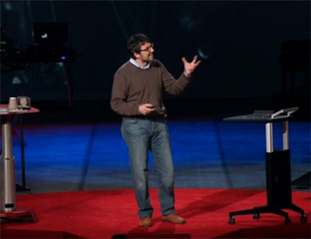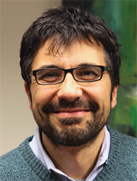| |
Silk-and its spinners-have become a hot topic in the fields of biomedicine and biotechnology in recent years. Indeed, the What A Year! September story featured Dr. Randy Lewis and his work to produce spider silk from alternative sources as a potential biomaterial. This month we focus on Dr. Fiorenzo Omenetto, who has developed with Dr. David Kaplan, a novel silk-based technology with the potential to transform biomedicine from the implantation of small electronic devices to drug delivery.
In our September story we mentioned that silk was first harvested from the silkworm bombyx mori in ancient China to over 4,000 years ago. To this day, silk is harvested from silkworms through a process called sericulture to create beautiful textiles and garments, among other uses. Silk is composed of a mixture of proteins and water that connect together into a protein structure called a matrix. Different types of protein embedded within the protein matrix determine the exact properties of the fiber, including strength and elasticity.
In order to harness the properties of these proteins, Dr. Omenetto breaks down the protein matrix of the silk into individual compound molecules by boiling the fibers with salt. Once the salt has been filtered away, only a solution of silk proteins and water remains - liquid silk. This liquid silk can then be transformed into other types of materials including films, tubes, blocks, or other three-dimensional configurations. "These are like magical bricks that we can use to build many other things," explains Dr. Omenetto.
In fact, Dr. Omenetto works with researchers all around the world to create novel therapies and technologies using silk-based devices. Drs. Omenetto and Kaplan and over 80 colleagues focus on the material platform of these devices to improve their chemical and mechanical properties to suit the particular needs of these applications. Here we will give you two examples of the types of devices and technologies Dr. Omenetto and his colleagues are pursuing: improved vaccine storage within a silk protein matrix and surgical sutures that also monitor wound healing.
Improved Vaccine Storage
One major problem with current vaccines and antibiotics is the cold temperature they must remain at throughout the process of manufacturing, transportation, and then storage. This makes the cost of production very high, and can result in the loss of viable vaccines and antibiotics if temperatures rise too much.
To address this issue, Dr. Omenetto and his colleagues hypothesized that vaccines and antibiotics could be stabilized within a silk protein matrix, which would increase temperature tolerance (Zhang et al. 2012). These researchers tested this hypothesis by mixing the vaccines and antibiotics into the liquid silk solution before it solidified. For these experiments, they tested three compounds: the mumps, measles and rubella or MMR vaccine, and two antibiotics, penicillin and tetracycline, which treat a variety of bacterial infections. They then stored the resulting matrices at increasing temperatures (4 to 60 degrees Celsius which is 39 to 140 degrees Fahrenheit) and measured the stability of the compounds over a period of months. The researchers found that all of the compounds stored within the silk matrix remained viable at temperatures up to 60 degrees Celsius for more than six months. These results indicate that stabilization within a silk protein matrix could be an effective strategy for storing and delivering vaccines and antibiotics, especially in countries that lack suitable refrigeration infrastructure.
Surgical Sutures
Dr. Omenetto and reseachers at the University of Illinois are working to develop silk-based surgical sutures that could monitor wound healing. Similar sutures have already been developed based on platforms of metals or other inorganic materials. A silk-based platform would be beneficial because it is dissolvable and compatible with the immune system. The researchers developed sutures that could monitor temperature and deliver heat by adding silicon membranes to a silk-based platform. These sutures were tested in mouse models to demonstrate that the mice received the treatment safely and that the treatment effectively delivered heat. Similar sutures were developed and tested that would monitor pH in addition to temperature. The results show that silk-based devices with additional functions such as wound monitoring are a potentially effective and useful advance in biotechnology.
Other Applications
These are two examples of how silk-based technologies could shape the future of biomedicine and biotechnology. In addition to the therapies described above, Dr. Omenetto and his colleagues are also working on a variety of silk-based optical devices and electronic systems (Tao et al. 2012), among other projects. The possibilities of silk-based technologies are almost endless!
Dr. Fiorenzo Omenetto is the Frank C. Doble Professor of Biomedical Engineering at Tufts University. His current work focuses on the use of silk-based technologies in biomedicine. When not in the lab, Dr. Omenetto enjoys basketball, photography, music, and being sillier than his kids.

Dr. Omenetto giving a TED Talk
To Learn More:
- Tao, H. et al. 2012. "Implantable, multifunctional, bioresorbable optics." Proceedings of the National Academy of Sciences, 109(48): 19584-89.
- 2. Zhang, J. et al. 2012. "Stabilization of vaccines and antibiotics in silk and eliminating the cold chain." Proceedings of the National Academy of Sciences, 109(30): 11981-86.
- 3. Dae-Hyeong, K. et al. 2012. "Thin, Flexible Sensors and Actuators as "Instrumented"" Surgical Sutures for Targeted Wound Monitoring and Therapy."" Small, 8(21): 3263-68.
For More Information:
- TED http://www.ted.com/talks/lang/en/fiorenzo_omenetto_silk_the_ancient_material_of_the_future.html
- NPR http://www.npr.org/blogs/health/2012/09/26/161815537/medical-electronics-built-to-last-only-a-little-while
Written by Rebecca Kranz with Andrea Gwosdow, PhD at www.gwosdow.com
HOME | ABOUT | ARCHIVES | TEACHERS | LINKS | CONTACT
All content on this site is © Massachusetts
Society for Medical Research or others. Please read our copyright
statement — it is important. |
|
|
 Dr. Fiorenzo Omenetto
 Dr. Omenetto's TED Talk
Sign Up for our Monthly Announcement!
...or  subscribe to all of our stories! subscribe to all of our stories!

What A Year! is a project of the Massachusetts
Society for Medical Research.
|
|

